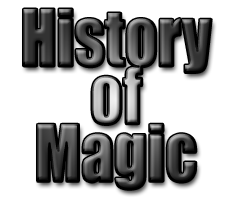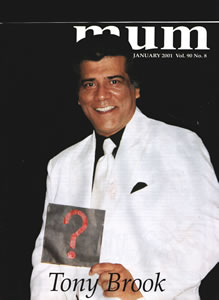
 |
 |

Cover of Jan. '01 Issue of MUM |
| � |
|
� |
| � | � |
|
(Actually, A Brief History of Magic) Of necessity, any article on the history of magic must be relatively brief. To cover the entire history of magic since the dawn of time would require years of study and research and once completed would take almost as long to write. It would fill several tomes. For the purposes of our site, our aim is to cover a very brief outline of the history of magic within a timeline framework. There are many references to Magic in the Bible and in ancient manuscripts. The three Wise Men are also referred to as the three Magi. A magician, at the time of Christ, known as Simon Magus was considered to be the Copperfield of his day and even managed to entertain his audiences by flying from one end of a room to the other! Much of modern magic as an art form and profession can trace its roots back to the ancient Egyptians. It can also trace its roots back to the ancient Chinese civilizations. One of the oldest effects in magic is known as The Chinese Linking Rings in which, several solid metal rings link and unlink themselves. Today, many magicians still use this effect. To be fair to modern magicians, they are quite different to their predecessors. Today's magicians consider themselves as Entertainers. Their ancient predecessors were either charlatans, mountebanks, impostors, conmen and thieves. Quite often a combination of all five. Back
to Egyptians. A man known as Dedi entertained, with magical effects,
the slaves that built the pyramids. He made chickens and pigeons
disappear and reappear. He had the heads of chickens removed and
replaced. He is also credited with inventing an effect called "
The Cups and Balls" in which a ball placed under one of three cups,
appears under another and then another. Finally, it disappears and
is replaced by a larger ball. This effect like the Chinese Linking
Rings has also withstood the test of time and is still being performed
today and can even be seen on television shows and in top showrooms
of the world. Magicians were hired by temple constructors to make
doors open, apparently by themselves, on the arrival or departure
of a person. Quite often a royal personage. These royal persons
had no idea how the effect was performed they simply believed that
they were responsible for these magical occurrences because of some
divine power that they alone possessed. Magicians also created effects to make stone gods talk or spew flames from their mouths. Magicians during those times were considered as Sorcerers and were quite different from the modern magical Entertainers of today. Ancient Magicians went to great lengths in order to convince their audiences to believe that they possessed supernatural powers. In the Middle Ages, many Palaces and Royal Courts had a resident magician. He was usually a soothsayer and an astrologist as well. Many of them through the use of magical effects gained a reputation of turning base metal into gold. Magic could be found in the travelling road shows and in the London fairs of the 18th century. Drawings dating back to 1721, about Bartholomew Fair and Southwark Fair depict a magician named Fawkes doing a trick with a dove. Fawkes had a successful career running the fairs in England and it is reputed that he made a large fortune, lost it and made another large fortune. In 1735 an American magician named "Filadelphia" came to Europe. Frederick, the Great, became his benefactor. He and Frederick became so close that some nobles conspired to banish him from the court. Filadelphia decided to leave in splendid magical style. According to records from the time, when he finally left Berlin, his carriage was seen leaving at the same time from the four gates of the city. John Henry Anderson, known as the Wizard of the North, performed before the young Queen Victoria. During his magical career he travelled some 250,000 miles throughout Britain, Europe, Australia and America - a remarkable feat in itself considering that it was well before the era of Transatlantic jets. In
the middle of the XIX century, Charles Mouton opened the doors of
the first entertainment theatre where the public paid for tickets
to watch magic shows. Prior to that the entertainment theatres were
simple rooms opened to the public to have a drink and watch some
magic free of charge. Meanwhile in Paris, in 1848, an elegant French
magician named Robert Houdin was making history with his Soir�es
Fantastiques (Fantastic Nights) He later rented a large room in
London and charged admission to his shows. Houdin was one of the
magical pioneers who used electricity and electro-magnetism in his
magic shows. He was also the first to present effects that defied
gravity. When he levitated his young son for the first time he wrote
that the audience just exploded with amazement and thunderous applause.
Known as the Father of Modern Magic, Robert-Houdin died in 1871.
During his illustrious career he even assisted the French Government
in quelling a rebellion in North Africa by performing an effect
using electro- magnetism. A full account of this true story can
be found in his 'Memoirs'. Another famous magician, Dr. Walford Bodie, was equally innovative. Bodie used Laughing Gas which, at the time, was used by Physicians as an anaesthetic. Bodie used the gas on volunteers from the audience to induce uncontrolled laughter, which also provoked the rest of the audience to laugh hysterically. Also in the middle of the XIX century an attraction named "Pepper's Ghost" arrived at London. There were several versions of that effect. However, what is noteworthy is that the public paid to watch the magic show. They entered a small room where there was a stage with a chair; someone from the audience was chosen, went on stage and sat in the chair. The audience watched with bated breath as they saw the volunteer slowly dissolve into thin air and without the usage of any covers or boxes; he was replaced by a gorilla. Equally fascinated they continued to watch as the gorilla slowly dissolved away and the volunteer appeared once more just as surprised as the rest of the audience. A few years later, having read Robert-Houdin's 'Memoirs of Robert Houdin' an Austrian card manipulator named Erik Weiss became so enchanted and amazed by the principles that Houdin stood for, that he changed his persona and became Harry Houdini. In 1873, an English magician named John Neville Maskelyne with his colleague, Cooke, opened a showroom in Piccadilly, London. The show was so successful that it played uninterrupted until 1903, when the show moved to St. George's Hall, with a new associate David Devant. Devant in his own right later went on to become equally famous and a bronze bust of him holding a set of Multiplying balls is on display at The Magic Circle headquarters in London. The bust is set on a revolving platform and is the centrepiece of the room appropriately called the Devant Room. Digressing for a moment, it is well worth visiting this room and the rest of The Magic Circle in London, England. A unique and magical experience all by itself. Now back to Maskelyne. Maskelyne's
show was the first experience that many young people had of a live
show at that time. Although at the turn of the century it was not
considered quite etiquette in polite society to take young women
to a common music-hall show, Mr. Maskelyne's show was considered
as perfectly acceptable and respectable. Those who continued to
avoid the music halls missed a lot of good magic shows. Carmo and
his lion disappearance inside a cage, Dante with his fountains,
Goldin and last but not least, Chung Ling Soo Many of these famous
magicians filled showrooms around the world. The Zig-Zag Girl ( Mismade Girl ) A frequent presence at Maskelyne shows was Robert Harbin, not only an excellent artist in his own right, but also one of this century's greatest creators of magical effects. He invented an effect, very much copied and imitated, called ZIG-ZAG. A young lady assistant was placed in an upright box and it was closed. At this point only her mid-section was visible. He upper torso was moved to one side and her lower body was moved to the other side. At all times the audience could see her mid-section. Once she was 'Zig- Zagged' parts of the box would be opened revealing her upper torso to one side and her legs on the other side. Her mid-section remained in the centre. Sometimes she would extend her hand and wave to the audience. The partially open box would then be closed and the entire door opened and out would step the young woman none the worse for wear. The original prototype of this illusion can be viewed at the Magic Circle in London. (For a look at the actual sawdust Harbin created while building the prototype, you'll have to visit the home of Michael Bailey, where it is securely kept since Harbin first presented the not-yet-complete illusion for Michael's input - SD). Harbin died in 1978, having successfully performed on stage, cabaret and television. Many professional Magicians consider him to be the first Grand Master of Magic. The Indian Rope Trick Many stage magicians performed an act called "The Indian Rope Trick". There is much illusion within the world of Illusion. There is, even today, among Magicians and Historians hot debates as to the fact if such an effect ever existed. Marco P�lo brought a story from China about a man who, in the open air, threw a rope into the air which, a young boy climbed until he disappeared. Over the years several professional magicians have visited India offering large sums to anyone who could perform the effect. The effect remains a great topic on controversy. There are those who have claimed to have seen the full Indian version in the open. In this version the Indian magician tosses a rope of about 18 feet in length into the air where it remains suspended. A young boy then climbs the rope and disappears. The magician then climbs the rope armed with a large hatchet and also disappears. Screams are heard and the boy's limbs, covered in blood fall to the ground. An assistant gathers them up and places them in a large basket. The Magician descends and upon reaching the ground opens the basket and the boy is found inside, whole and unharmed. In 1938 the owner of a circus in Britain offered 2000 dollars to anyone who could perform the effect at the famous Lord's cricket ground at St. John's Wood in London. The offer was doubled by "The Magic Circle" but was never claimed. Although several versions were presented on stage, apparently it was never performed in the open air. As stated earlier this is only a brief outline history of magic. Details on many great names such as Dunninger, Thurston, Blackstone, Cardini, Kellar, Bautier de Kolta, Robert Heller, Professor Hoffman, Herrmann, John Scarne, Paul Curry, Harry Baron, Bruce Elliot and an extensive list of similar notables have not been included yet. This, is a work in progress...to be continued. Give me time! Research
By : Alexander Tereso and Tony Brook Complilation By: Anthony Darkstone
& Cartel Written By : Tony
Brook - MWC Director of International Operations and Member
of MWC Panel of Advisors.
|
�2000-2009 MagicWebChannel.com
